sensor VOLVO XC90 2007 Owners Manual
[x] Cancel search | Manufacturer: VOLVO, Model Year: 2007, Model line: XC90, Model: VOLVO XC90 2007Pages: 268, PDF Size: 8.57 MB
Page 4 of 268

2007 Volvo XC90
WARNING!
If your vehicle is involved in an accident, unseen damage may affect you\
r vehicle's drivability and
safety.
pg. 4 Introduction
Volvo and the environment
Volvo is committed to the well being of its customers. As a natural part\
of this commitment, we care
about the environment in which we all live. Caring for the environment m\
eans an everyday involvement
in reducing our environmental impact.
Volvo's environmental activities are based on a holistic view, which mea\
ns we consider the overall
environmental impact of a product throughout its complete life cycle. In\
this context, design, production,
product use, and recycling are all important considerations.
In production, Volvo has partly or completely phased out several chemica\
ls including chloro-
fluorocarbons (CFCs), freons, lead chromates, naphtanates, asbestos, m\
ercury and cadmium; and reduced
the amount of chemicals used in our plants 50% since 1991.
Volvo was the first in the world to introduce into production a three-wa\
y catalytic converter with a heated
oxygen sensor in 1976. The current version of this highly efficient syst\
em reduces emissions of harmful
substances (CO, HC, NOx) from the exhaust pipe by approximately 95% an\
d the search to eliminate the
remaining emissions continues. Volvo is the only automobile manufacturer\
to offer CFC-free retrofit kits
for the air conditioning system of all models as far back as the 1975 Vo\
lvo 240. Advanced electronic
engine controls, refined purification systems and cleaner fuels are brin\
ging us closer to our goal.
After Volvo vehicles and parts have fulfilled their use, recycling is th\
e next critical step in completing the
life cycle. The metal content is about 75% of the total weight of a vehi\
cle, which makes the vehicle
among the most recycled industrial products. In order to have efficient \
and well controlled recycling,
many Volvo variants have printed dismantling manuals, indicating the wei\
ght and material of individual
components. For Volvo, all homogeneous plastic parts weighing more than \
1.7 oz. (50 grams) are marked
with international symbols that indicate how the component is to be sort\
ed for recycling.
In addition to continuous environmental refinement of conventional gasol\
ine-powered internal
combustion engines, Volvo is actively looking at advanced technology alt\
ernative-fuel vehicles.
When you drive a Volvo, you become our partner in the work to lessen the\
vehicle's impact on the
environment.
To reduce your vehicle's environmental impact, you can:
l Maintain proper air pressure in your tires. Tests have shown decreased f\
uel economy with improperly
inflated tires.
l Follow the recommended maintenance schedule in your Warranty and Service\
Records Information
booklet.
file:///K|/ownersdocs/2007/2007_XC90/07xc90_00.htm (4 of 7)12/30/2006 \
5:53:31 PM
Page 8 of 268

2007 Volvo XC90
2 0 0 7
VOLVO XC90
Safety
pg. 9 Safety
Occupant safety, Reporting safety
defects
10
Seat belts
12
Supplemental Restraint System (SRS)
15
Front airbags
16
Occupant Weight Sensor (OWS)
20
Side impact (SIPS) airbag
24
Volvo Inflatable Curtain (VIC)
25
Whiplash Protection System (WHIPS)
26
Child safety
28
Child restraint systems
31
Infant seats
33
Convertible seats
35
Booster cushions
37
ISOFIX lower anchors
38
Top tether anchors
39
Integrated booster cushion
40
pg. 10 Safety
Occupant safety, Reporting safety defects
Volvo concern for safety
file:///K|/ownersdocs/2007/2007_XC90/07xc90_01.htm (1 of 39)12/30/2006\
5:53:33 PM
Page 14 of 268
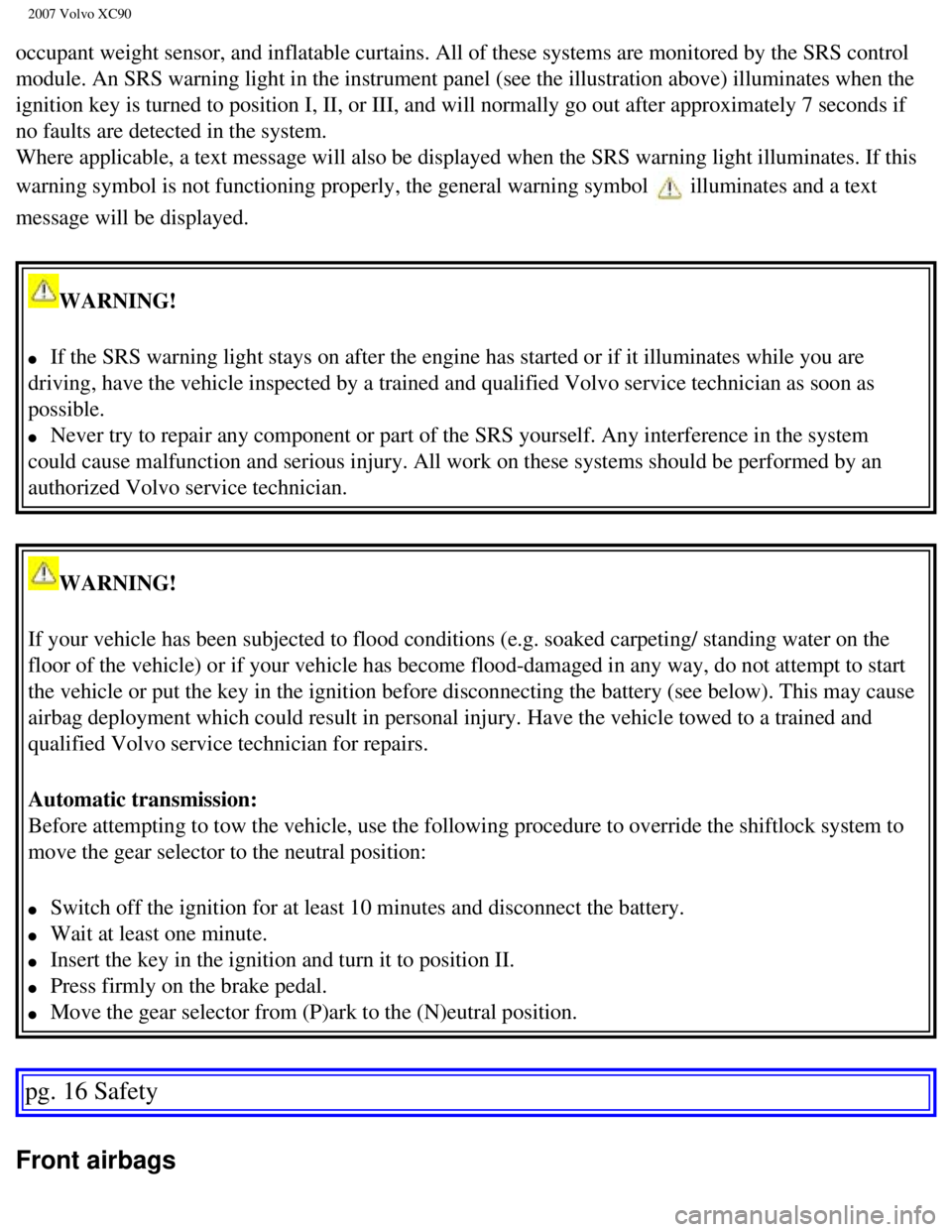
2007 Volvo XC90
occupant weight sensor, and inflatable curtains. All of these systems ar\
e monitored by the SRS control
module. An SRS warning light in the instrument panel (see the illustrat\
ion above) illuminates when the
ignition key is turned to position I, II, or III, and will normally go o\
ut after approximately 7 seconds if
no faults are detected in the system.
Where applicable, a text message will also be displayed when the SRS war\
ning light illuminates. If this
warning symbol is not functioning properly, the general warning symbol
illuminates and a text
message will be displayed.
WARNING!
l If the SRS warning light stays on after the engine has started or if it \
illuminates while you are
driving, have the vehicle inspected by a trained and qualified Volvo ser\
vice technician as soon as
possible.
l Never try to repair any component or part of the SRS yourself. Any inter\
ference in the system
could cause malfunction and serious injury. All work on these systems sh\
ould be performed by an
authorized Volvo service technician.
WARNING!
If your vehicle has been subjected to flood conditions (e.g. soaked car\
peting/ standing water on the
floor of the vehicle) or if your vehicle has become flood-damaged in an\
y way, do not attempt to start
the vehicle or put the key in the ignition before disconnecting the batt\
ery (see below). This may cause
airbag deployment which could result in personal injury. Have the vehicl\
e towed to a trained and
qualified Volvo service technician for repairs.
Automatic transmission:
Before attempting to tow the vehicle, use the following procedure to ove\
rride the shiftlock system to
move the gear selector to the neutral position:
l Switch off the ignition for at least 10 minutes and disconnect the batte\
ry.
l Wait at least one minute.
l Insert the key in the ignition and turn it to position II.
l Press firmly on the brake pedal.
l Move the gear selector from (P)ark to the (N)eutral position.
pg. 16 Safety
Front airbags
file:///K|/ownersdocs/2007/2007_XC90/07xc90_01.htm (7 of 39)12/30/2006\
5:53:33 PM
Page 15 of 268
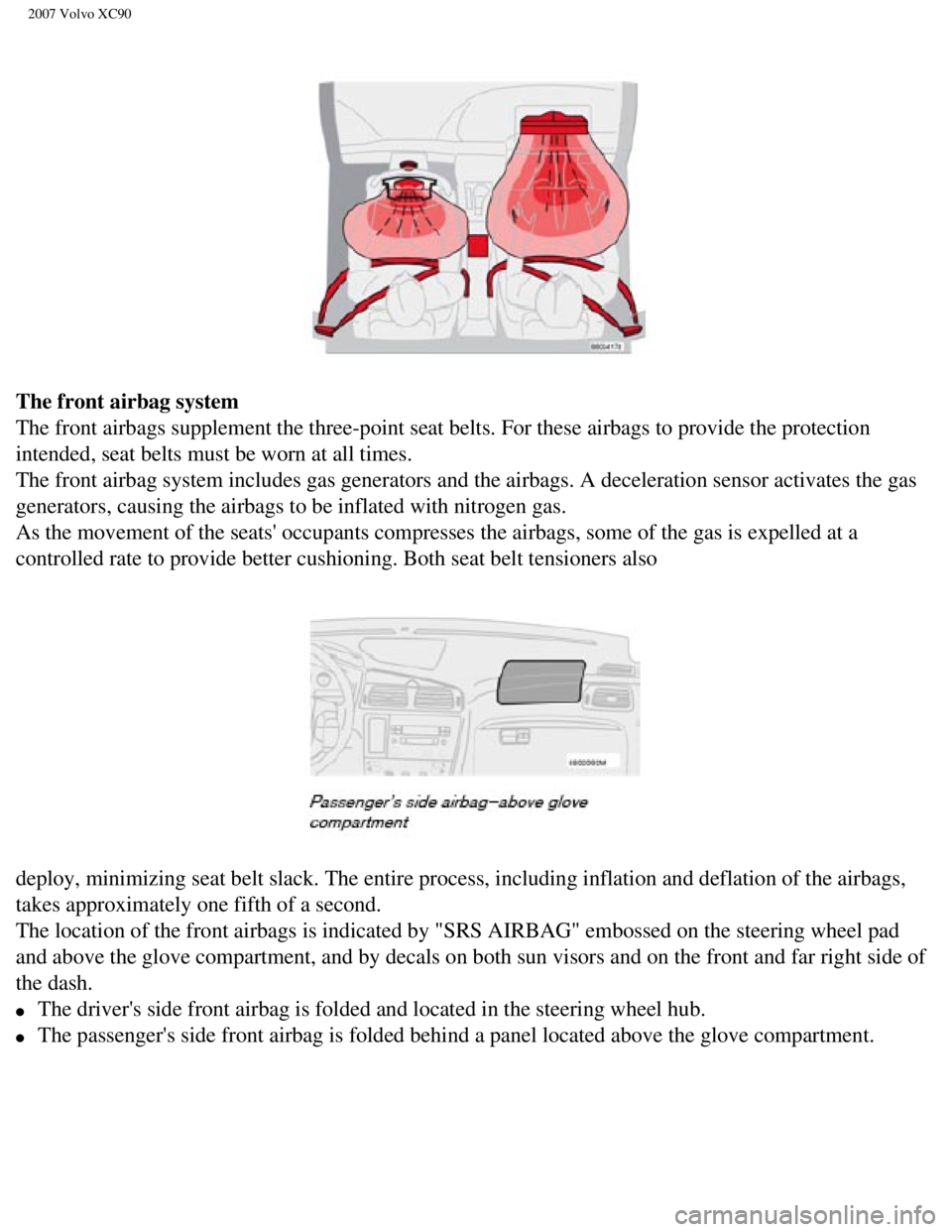
2007 Volvo XC90
The front airbag system
The front airbags supplement the three-point seat belts. For these airba\
gs to provide the protection
intended, seat belts must be worn at all times.
The front airbag system includes gas generators and the airbags. A decel\
eration sensor activates the gas
generators, causing the airbags to be inflated with nitrogen gas.
As the movement of the seats' occupants compresses the airbags, some of \
the gas is expelled at a
controlled rate to provide better cushioning. Both seat belt tensioners \
also
deploy, minimizing seat belt slack. The entire process, including inflat\
ion and deflation of the airbags,
takes approximately one fifth of a second.
The location of the front airbags is indicated by "SRS AIRBAG" embossed \
on the steering wheel pad
and above the glove compartment, and by decals on both sun visors and on\
the front and far right side of
the dash.
l The driver's side front airbag is folded and located in the steering whe\
el hub.
l The passenger's side front airbag is folded behind a panel located above\
the glove compartment.
file:///K|/ownersdocs/2007/2007_XC90/07xc90_01.htm (8 of 39)12/30/2006\
5:53:33 PM
Page 16 of 268
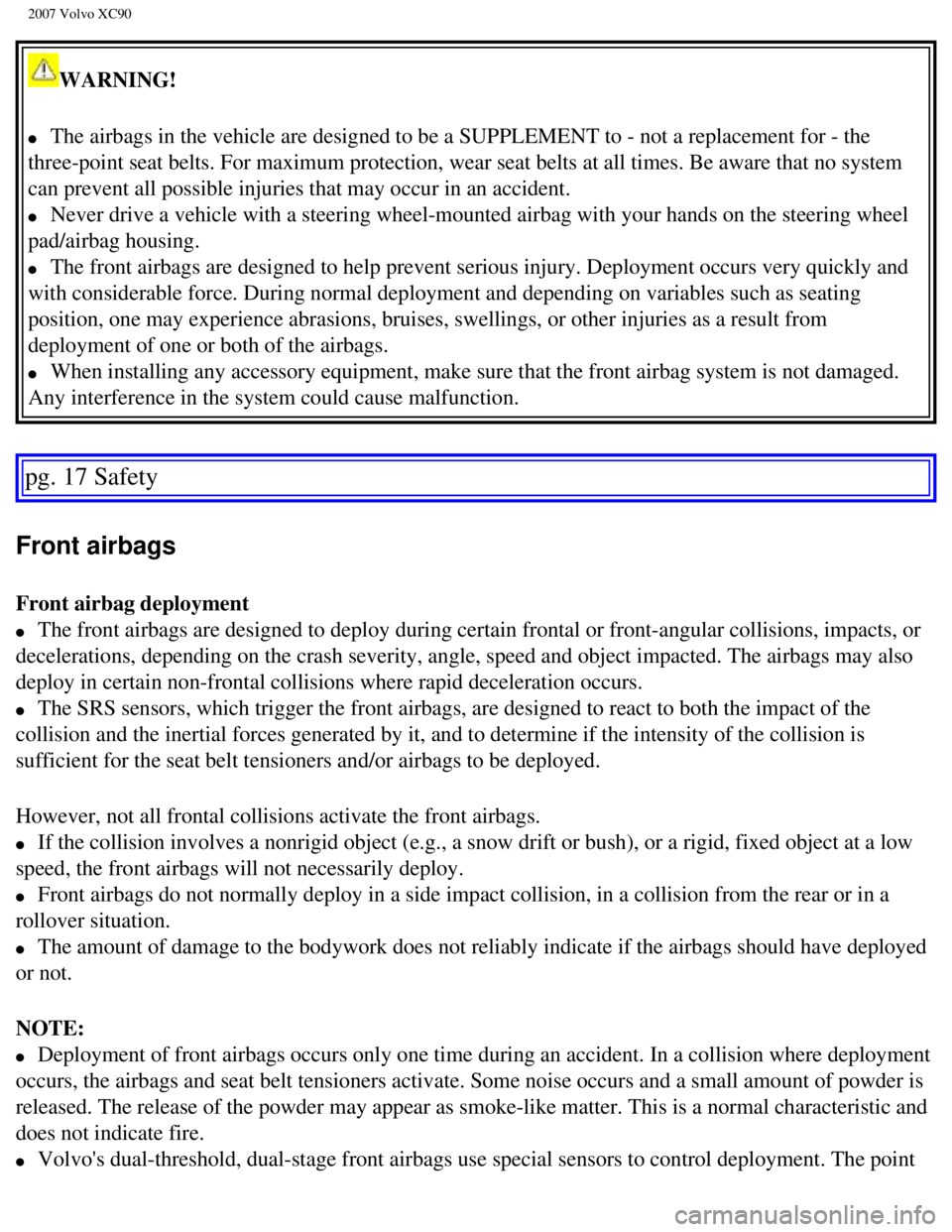
2007 Volvo XC90
WARNING!
l The airbags in the vehicle are designed to be a SUPPLEMENT to - not a re\
placement for - the
three-point seat belts. For maximum protection, wear seat belts at all t\
imes. Be aware that no system
can prevent all possible injuries that may occur in an accident.
l Never drive a vehicle with a steering wheel-mounted airbag with your han\
ds on the steering wheel
pad/airbag housing.
l The front airbags are designed to help prevent serious injury. Deploymen\
t occurs very quickly and
with considerable force. During normal deployment and depending on varia\
bles such as seating
position, one may experience abrasions, bruises, swellings, or other inj\
uries as a result from
deployment of one or both of the airbags.
l When installing any accessory equipment, make sure that the front airbag\
system is not damaged.
Any interference in the system could cause malfunction.
pg. 17 Safety
Front airbags
Front airbag deployment
l The front airbags are designed to deploy during certain frontal or front\
-angular collisions, impacts, or
decelerations, depending on the crash severity, angle, speed and object \
impacted. The airbags may also
deploy in certain non-frontal collisions where rapid deceleration occurs\
.
l The SRS sensors, which trigger the front airbags, are designed to react \
to both the impact of the
collision and the inertial forces generated by it, and to determine if t\
he intensity of the collision is
sufficient for the seat belt tensioners and/or airbags to be deployed.
However, not all frontal collisions activate the front airbags.
l If the collision involves a nonrigid object (e.g., a snow drift or bush\
), or a rigid, fixed object at a low
speed, the front airbags will not necessarily deploy.
l Front airbags do not normally deploy in a side impact collision, in a co\
llision from the rear or in a
rollover situation.
l The amount of damage to the bodywork does not reliably indicate if the a\
irbags should have deployed
or not.
NOTE:
l Deployment of front airbags occurs only one time during an accident. In \
a collision where deployment
occurs, the airbags and seat belt tensioners activate. Some noise occurs\
and a small amount of powder is
released. The release of the powder may appear as smoke-like matter. Thi\
s is a normal characteristic and
does not indicate fire.
l Volvo's dual-threshold, dual-stage front airbags use special sensors to \
control deployment. The point
file:///K|/ownersdocs/2007/2007_XC90/07xc90_01.htm (9 of 39)12/30/2006\
5:53:33 PM
Page 18 of 268
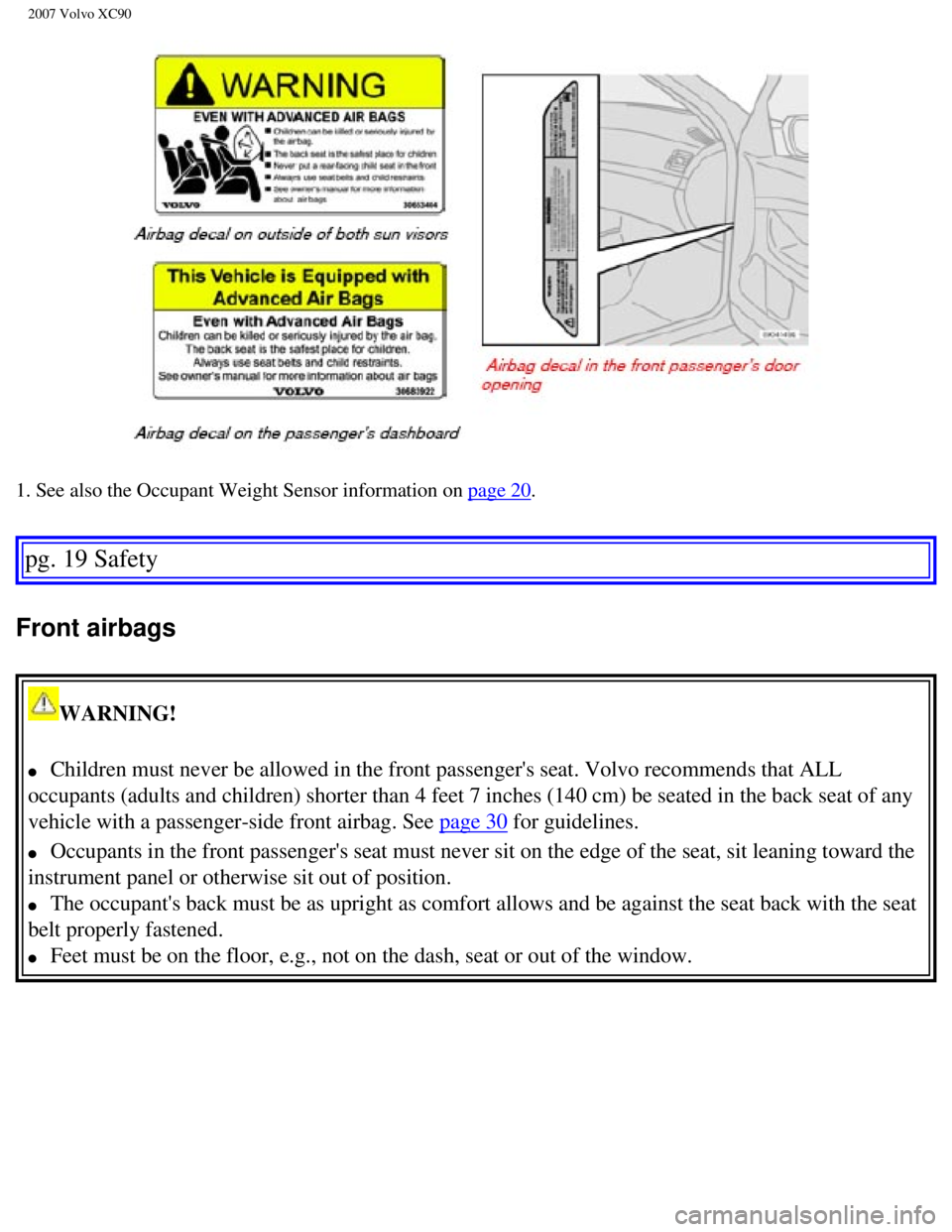
2007 Volvo XC90
1. See also the Occupant Weight Sensor information on page 20.
pg. 19 Safety
Front airbags
WARNING!
l Children must never be allowed in the front passenger's seat. Volvo reco\
mmends that ALL
occupants (adults and children) shorter than 4 feet 7 inches (140 cm)\
be seated in the back seat of any
vehicle with a passenger-side front airbag. See
page 30 for guidelines.
l Occupants in the front passenger's seat must never sit on the edge of th\
e seat, sit leaning toward the
instrument panel or otherwise sit out of position.
l The occupant's back must be as upright as comfort allows and be against \
the seat back with the seat
belt properly fastened.
l Feet must be on the floor, e.g., not on the dash, seat or out of the win\
dow.
file:///K|/ownersdocs/2007/2007_XC90/07xc90_01.htm (11 of 39)12/30/200\
6 5:53:33 PM
Page 19 of 268

2007 Volvo XC90
WARNING!
l No objects or accessory equipment, e.g. dashboard covers, may be placed \
on, attached to, or
installed near the air bag hatch (the area above the glove compartment)\
or the area affected by airbag
deployment (see the illustration on
page 16).
l There should be no loose articles, e.g. coffee cups, on the floor, seat,\
or dashboard area.
l Never try to open the airbag cover on the steering wheel or the passenge\
r's side dashboard. This
should only be done by a trained and qualified Volvo service technician.\
Failure to follow these instructions can result in injury to the vehicle\
occupants.
pg. 20 Safety
Occupant Weight Sensor (OWS)
Disabling the passenger's side front airbag
Volvo recommends that ALL occupants (adults and children) shorter than\
4 feet 7 inches (140 cm) be
seated in the rear seat of any vehicle with a passenger's side front air\
bag, and be properly restrained.
Children should always be seated in child restraints appropriate for the\
ir size and weight. See also the
child safety recommendations beginning on
page 31.
The Occupant Weight Sensor (OWS) is designed to meet the regulatory re\
quirements of Federal Motor
Vehicle Safety Standard (FMVSS) 208 and is designed to disable (will \
not inflate) the passenger's side
front airbag under certain conditions. The OWS works with sensors that a\
re part of the front passenger's
seat and seat belt. The sensors are designed to detect the presence of a\
properly seated occupant and
determine if the passenger's side front airbag should be enabled (may i\
nflate) or disabled (will not
inflate).
file:///K|/ownersdocs/2007/2007_XC90/07xc90_01.htm (12 of 39)12/30/200\
6 5:53:33 PM
Page 20 of 268
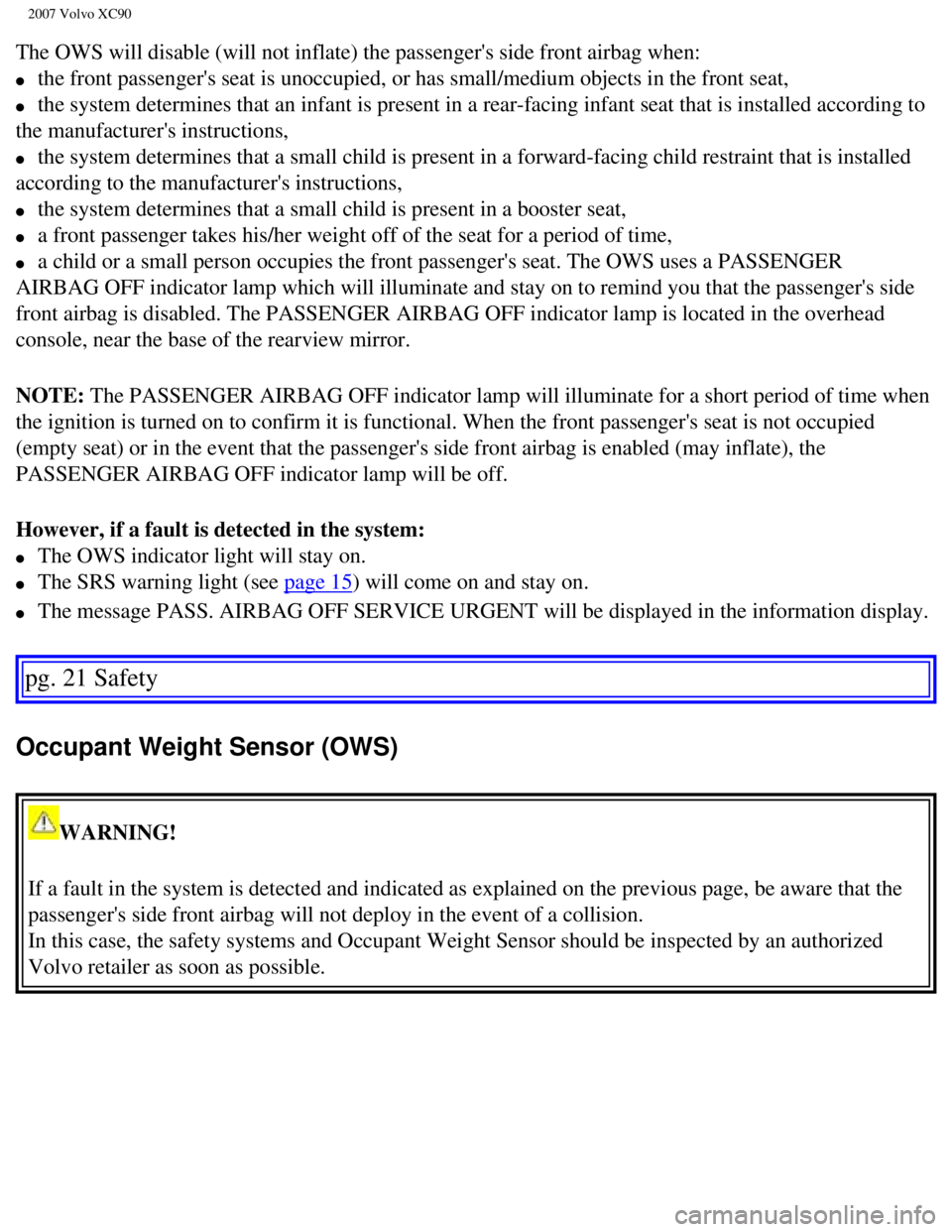
2007 Volvo XC90
The OWS will disable (will not inflate) the passenger's side front air\
bag when:
l the front passenger's seat is unoccupied, or has small/medium objects in\
the front seat,
l the system determines that an infant is present in a rear-facing infant \
seat that is installed according to
the manufacturer's instructions,
l the system determines that a small child is present in a forward-facing \
child restraint that is installed
according to the manufacturer's instructions,
l the system determines that a small child is present in a booster seat,
l a front passenger takes his/her weight off of the seat for a period of t\
ime,
l a child or a small person occupies the front passenger's seat. The OWS u\
ses a PASSENGER
AIRBAG OFF indicator lamp which will illuminate and stay on to remind yo\
u that the passenger's side
front airbag is disabled. The PASSENGER AIRBAG OFF indicator lamp is loc\
ated in the overhead
console, near the base of the rearview mirror.
NOTE: The PASSENGER AIRBAG OFF indicator lamp will illuminate for a short per\
iod of time when
the ignition is turned on to confirm it is functional. When the front pa\
ssenger's seat is not occupied
(empty seat) or in the event that the passenger's side front airbag is\
enabled (may inflate), the
PASSENGER AIRBAG OFF indicator lamp will be off.
However, if a fault is detected in the system:
l The OWS indicator light will stay on.
l The SRS warning light (see page 15) will come on and stay on.
l The message PASS. AIRBAG OFF SERVICE URGENT will be displayed in the inf\
ormation display.
pg. 21 Safety
Occupant Weight Sensor (OWS)
WARNING!
If a fault in the system is detected and indicated as explained on the p\
revious page, be aware that the
passenger's side front airbag will not deploy in the event of a collisio\
n.
In this case, the safety systems and Occupant Weight Sensor should be in\
spected by an authorized
Volvo retailer as soon as possible.
file:///K|/ownersdocs/2007/2007_XC90/07xc90_01.htm (13 of 39)12/30/200\
6 5:53:33 PM
Page 22 of 268

2007 Volvo XC90
OFF indicator lamp will be off and remain off.
If a person of adult size is sitting in the front passenger's seat, but \
the PASSENGER AIRBAG OFF
indicator lamp is on, it is possible that the person isn't sitting prope\
rly in the seat. If this happens:
l Turn the vehicle off and ask the person to place the seat back in an upr\
ight position.
pg. 22 Safety
Occupant Weight Sensor (OWS)
l Have the person sit upright in the seat, centered on the seat cushion, w\
ith the person's legs
comfortably extended.
l Restart the vehicle and have the person remain in this position for abou\
t two minutes. This will allow
the system to detect that person and enable the passenger's frontal airb\
ag.
l If the PASSENGER AIRBAG OFF indicator lamp remains on even after this, t\
he person should be
advised to ride in the rear seat.
This condition reflects limitations of the OWS classification capability\
. It does not indicate OWS
malfunction.
Modifications
If you are considering modifying your vehicle in any way to accommodate \
a disability, for example by
altering or adapting the driver's or front passenger's seat(s) and/or \
airbag systems, please contact Volvo
at:
In the USA:
Volvo Cars of North America, LLC
Customer Care Center
P.O. Box 914
Rockleigh, New Jersey 07647-0914
1-800-458-1552
In Canada:
Volvo Cars of Canada Corp.
National Customer Service
175 Gordon Baker Road
North York, Ontario M2H 2N7
1-800-663-8255
file:///K|/ownersdocs/2007/2007_XC90/07xc90_01.htm (15 of 39)12/30/200\
6 5:53:33 PM
Page 23 of 268
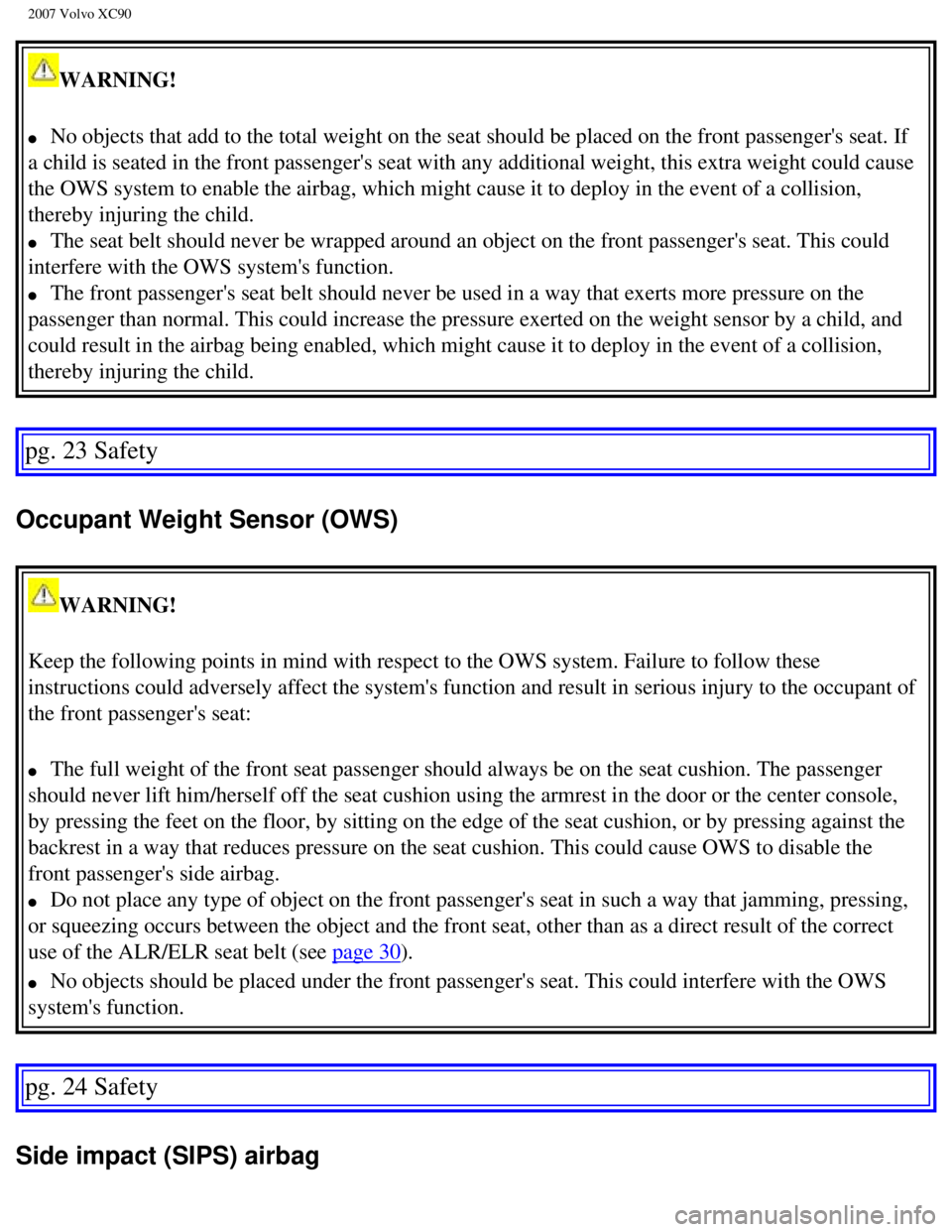
2007 Volvo XC90
WARNING!
l No objects that add to the total weight on the seat should be placed on \
the front passenger's seat. If
a child is seated in the front passenger's seat with any additional weig\
ht, this extra weight could cause
the OWS system to enable the airbag, which might cause it to deploy in t\
he event of a collision,
thereby injuring the child.
l The seat belt should never be wrapped around an object on the front pass\
enger's seat. This could
interfere with the OWS system's function.
l The front passenger's seat belt should never be used in a way that exert\
s more pressure on the
passenger than normal. This could increase the pressure exerted on the w\
eight sensor by a child, and
could result in the airbag being enabled, which might cause it to deploy\
in the event of a collision,
thereby injuring the child.
pg. 23 Safety
Occupant Weight Sensor (OWS)
WARNING!
Keep the following points in mind with respect to the OWS system. Failur\
e to follow these
instructions could adversely affect the system's function and result in \
serious injury to the occupant of
the front passenger's seat:
l The full weight of the front seat passenger should always be on the seat\
cushion. The passenger
should never lift him/herself off the seat cushion using the armrest in \
the door or the center console,
by pressing the feet on the floor, by sitting on the edge of the seat cu\
shion, or by pressing against the
backrest in a way that reduces pressure on the seat cushion. This could \
cause OWS to disable the
front passenger's side airbag.
l Do not place any type of object on the front passenger's seat in such a \
way that jamming, pressing,
or squeezing occurs between the object and the front seat, other than as\
a direct result of the correct
use of the ALR/ELR seat belt (see
page 30).
l No objects should be placed under the front passenger's seat. This could\
interfere with the OWS
system's function.
pg. 24 Safety
Side impact (SIPS) airbag
file:///K|/ownersdocs/2007/2007_XC90/07xc90_01.htm (16 of 39)12/30/200\
6 5:53:33 PM